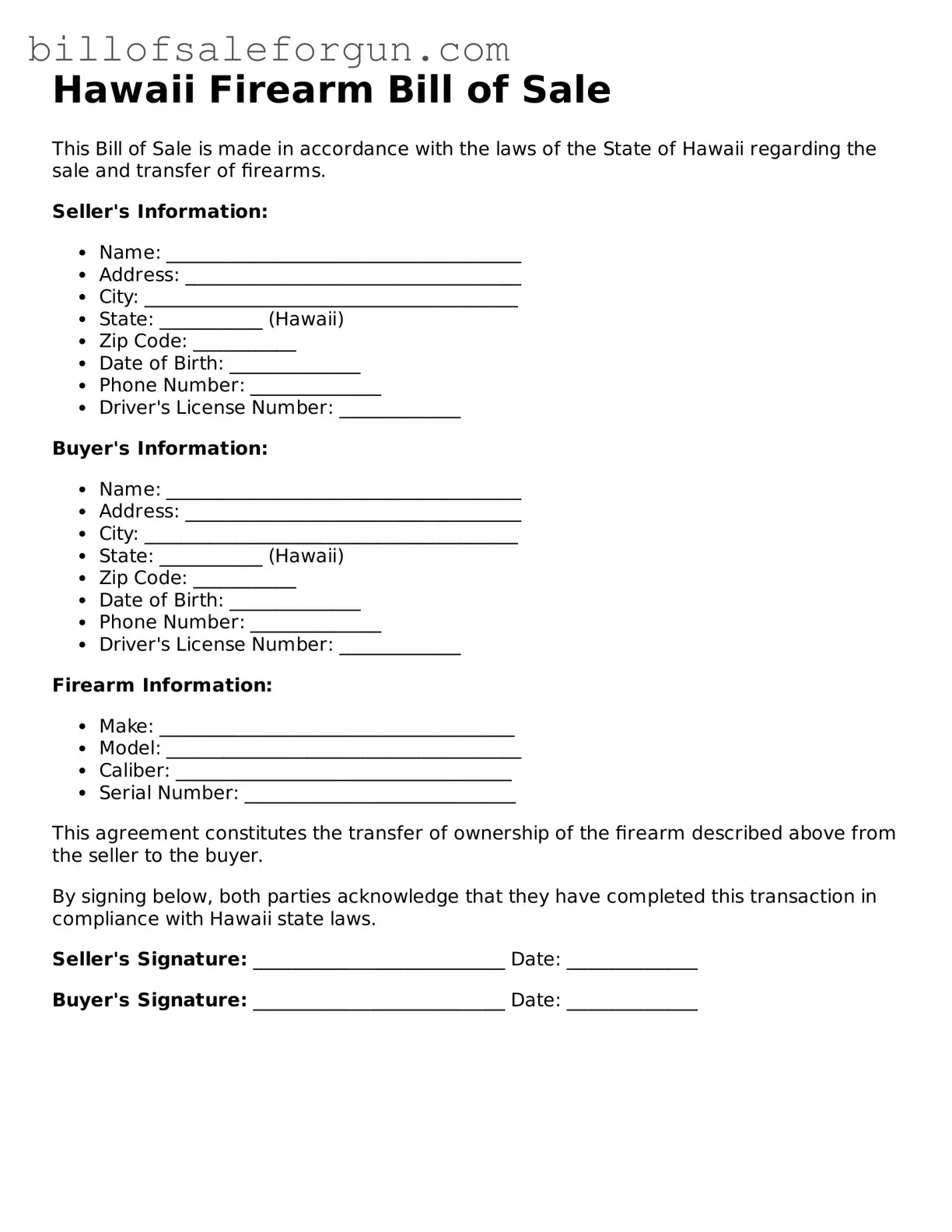Similar forms
The Hawaii Firearm Bill of Sale form is similar to the Vehicle Bill of Sale. Both documents serve as proof of transfer of ownership from one party to another. The Vehicle Bill of Sale typically includes details such as the buyer's and seller's information, vehicle identification number (VIN), make, model, and sale price. Like the firearm bill of sale, it is crucial for registering the vehicle with the state and can be used to resolve disputes regarding ownership.
Another document comparable to the Hawaii Firearm Bill of Sale is the Boat Bill of Sale. This document facilitates the transfer of ownership of a boat and includes information about the buyer and seller, boat details, and the sale price. Both documents require signatures from both parties to validate the transaction. They serve as legal evidence of ownership transfer, which can be important for future registration or legal purposes.
The Personal Property Bill of Sale is also similar to the Hawaii Firearm Bill of Sale. This document is used to transfer ownership of tangible personal property, which can include items like furniture, electronics, or collectibles. Like the firearm bill of sale, it captures the essential details of the transaction, including the description of the item, the purchase price, and the parties involved. This document protects both the buyer and seller by providing a record of the transaction.
The Real Estate Purchase Agreement shares similarities with the Hawaii Firearm Bill of Sale in that both are used to formalize the transfer of ownership. The Real Estate Purchase Agreement outlines the terms and conditions of the sale, including the purchase price and any contingencies. While the real estate document is more complex, both serve to protect the interests of the parties involved and require signatures to finalize the agreement.
The Lease Agreement is another document that bears resemblance to the Hawaii Firearm Bill of Sale. While a lease does not transfer ownership, it establishes the terms under which one party can use another's property. Both documents require clear identification of the parties involved, a description of the property, and the terms of the agreement. They both serve to protect the rights of the parties and provide a legal framework for the transaction.
The Equipment Bill of Sale is akin to the Hawaii Firearm Bill of Sale as it facilitates the transfer of ownership of specific equipment, such as machinery or tools. This document includes details about the equipment, the sale price, and the parties involved. Both forms provide essential documentation that can be used to verify ownership and resolve any disputes that may arise after the sale.
The Pawn Ticket is similar to the Hawaii Firearm Bill of Sale in that it records a transaction involving the transfer of possession of an item, often in exchange for a loan. While the pawn ticket does not transfer ownership outright, it serves as a temporary agreement that details the item, loan amount, and terms of repayment. Both documents help protect the interests of the parties involved and provide a record of the transaction.
The Firearm Transfer Record is another document closely related to the Hawaii Firearm Bill of Sale. This record is often required by law to document the transfer of firearms between individuals. It includes information about the firearm, the buyer, and the seller. Both documents serve as proof of the transaction and may be necessary for compliance with local laws regarding firearm ownership.
The Gift Receipt can also be compared to the Hawaii Firearm Bill of Sale. This document is used when one person gives an item to another without any exchange of money. While it does not involve a sale, it still documents the transfer of ownership. Both forms require details about the item and the parties involved, serving as proof of the transaction for future reference.
Finally, the Donation Receipt is similar to the Hawaii Firearm Bill of Sale in that it documents the transfer of ownership of an item, typically for charitable purposes. This document includes information about the donor, the recipient, and the item being donated. Both documents serve to provide a clear record of the transaction, which can be important for tax or legal reasons.
